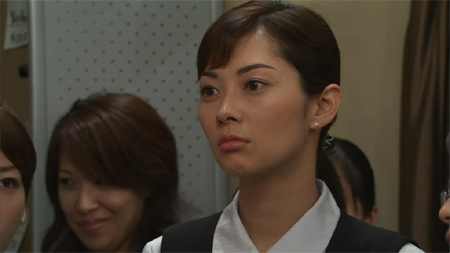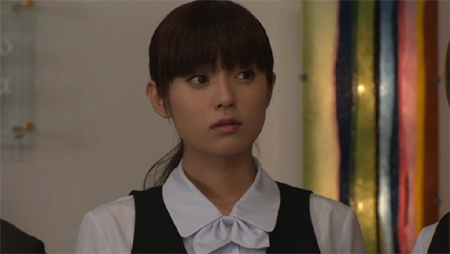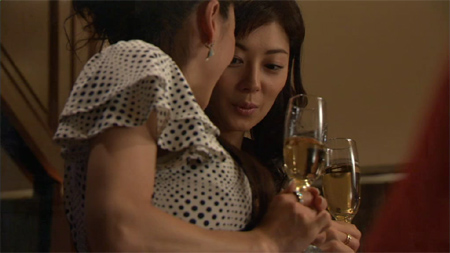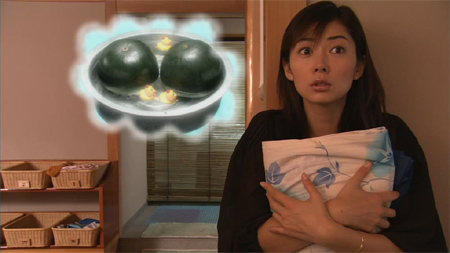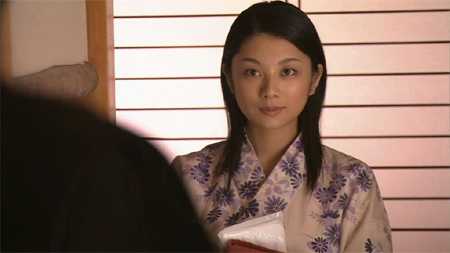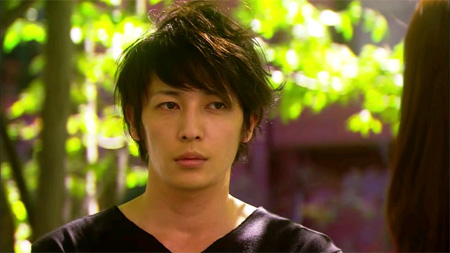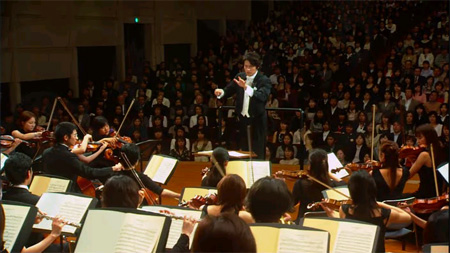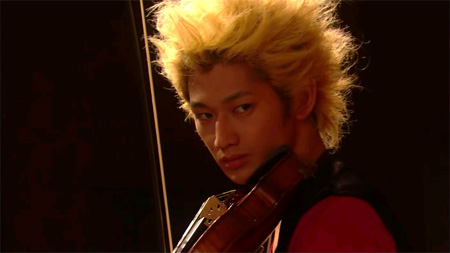I may have spoken too soon…
Yesterday I said that I’ve started watching dramas as they aired because subbing groups are so fast these days. Usually I wait until subtitles for the entire series are completed so that I can watch all the episodes continuously and not be stranded in the middle of a show. Well, I just found out that the subber for Papa to Musume no Nanokan has quit her project halfway through the series. Details are here, check it out to see some of the members throwing hissy fits. We have to remember that subbers take on projects purely for their own enjoyment and make no money, so appreciate them!
My Japanese skills are only adequate enough to understand roughly 30% of the average episode, but since I’m already hooked on this series, I think I’ll continue watching it. Stay tuned for impressions soon.
Yama Onna Kabe Onna impressions
Usually I prefer waiting for a drama series to finish airing in its entirety before starting to watch it. This way I don’t stuck halfway through the season, waiting for weeks hoping for somebody to post subtitles. However, subbing teams are so on the ball nowadays that during this summer drama season, I’ve been following two series as they air. They’re so quick and reliable that you can download both the newest episode and the accompanying subtitles within a couple days of the Japanese airing. As always, check out the community at D-Addicts for details on the hottest dramas, new and old.
Coincidentally, I caught the premiere episodes of both these series “live” on TV while I was in Japan. One show is called Papa to Musume no Nanokakan and stars Aragaki Yui. I’ll talk about that one next time.
The topic for today is the comedy Yama Onna Kabe Onna, which stars Itoh Misaki, probably best known as the elegant Hermes lady in the drama Densha Otoko. She plays a luxury bag saleswoman named Aoyagi Megumi who works in a premiere Ginza department store. Unfortunately, her work attire isn’t very flattering; for that classic Hermes / Itoh Misaki look, you’ll have to wait for the scenes when she’s not at work.
Anyway, Aoyagi is a top selling bag saleswoman, but she has one small problem: she’s quite self conscious about her chest. That “A cup complex” is compounded when a new girl, Mariya Marie (played by Fukada Kyoko), with an enormous bust is transferred into the department store. She just so happens to be an excellent saleswoman as well, which makes Aoyagi feel even worse.
If you know Japanese, the title of this show now makes perfect sense. Yama Onna = mountain woman. Kabe Onna = wall woman.
As you might expect from the premise, breast related humor is very prevalent in Yama Onna Kabe Onna. On the serious side, the focus seems to be on Aoyagi struggling with her insecurities, though there’s also a little lecturing on what it means to work in a department store and to offer premium service. If you’ve ever been to a Japanese mall (or even a Japanese-owned mall in Taiwan or other Asian countries), you should be quite familiar with that level of service.
But for the most part, the show is about:
And what the heck, for good measure:
Not that there’s anything wrong with that, of course. Yama Onna Kabe Onna is funny and Itoh Misaki is charming as always. However, four episodes have aired so far and it’s been pretty one-dimensional up to this point. I don’t expect that’ll change much, but stay tuned for a post-mortem when the series is finished in a couple months. I think there’s eight episodes left.
Other characters of note:
Ooyama Haruka (played by Koike Eiko). She is Aoyagi’s hostile rival, both professionally and romantically. She doesn’t miss an opportunity to get a jab in about Aoyagi’s chest. Quite evil looking, I must say. In real life, Koike Eiko is a gravure idol with plentiful assets.
Yoshino Kanako (played by Uehara Misa). She is a co-worker of Aoyagi and a supporting character who’s there for comic relief. You might remember Uehara Misa from the drama Nodame Cantabile, where she played Chiaki Shinichi’s ex-girlfriend.
Facts
12 episodes
Airing Summer 2007
Genre: Comedy
Links
Official site
D-Addicts Bittorrent download page
Subtitles
Nodame Cantabile
It’s been awhile since my last Asian drama review and I had a couple sitting on the backburners, so let’s start off with the immensely popular Nodame Cantabile!
One of the reasons I prefer Japanese dramas to Chinese or Korean ones (even though Korean dramas are all the rage in Asia) is the greater variety. Whether that’s an actual fact or simply perceived reality is unknown to me, but Nodame Cantabile, a drama about classical music and student orchestras, seems uniquely Japanese.
The drama features two main characters. Chiaki Shinichi (played by Tamaki Hiroshi) is an extremely talented pianist and the top student at Momogaoka College of Music. He was born into a musical family and was fortunate enough to receive world class instruction from renowned instructors starting at an early age. Even though he’s haughty because of his skills and perfectionist attitude, the rest of the students nevertheless admire him, particularly the girls. But Chiaki feels confined staying in Japan and longs to pursue his dream of becoming an orchestra conductor by studying abroad.
The other main character is Noda Megumi (Nodame for short, played by Ueno Juri). She’s the polar opposite of Chiaki: a childish slob who often forgets to take baths and lives in an atrocious mess of a room. Though she actually has hidden piano talent, she plays piano according to her heart (which is a nice way of saying sloppily) and not precisely to the sheet music. In fact, even though she is attending a music college, she desires to be a kindergarten teacher.
When the two meet one day, Nodame falls instantly in love with the popular Chiaki. He is baffled and disturbed by this wacky girl, but becomes a little intrigued when the two are paired up to practice a piano duet. And so begins their wacky relationship, with an adoring girl chasing after an aloof star.
Fundamentally, Nodame Cantabile is a romantic comedy, but major emphasis is placed upon the classical music. Early on in the series, Chiaki transfers from piano to the conducting division and has an opportunity to be the conductor for a student orchestra. The concert performances by the orchestra are not shown in their entirety, but whole minutes can pass with only footage of the students playing and not a word spoken.
Don’t let that scare you off though, even if you hate classical music. As anybody who enjoys music should know, powerful emotions can be conveyed through music and the acting doesn’t stop just because the actors are playing instruments.
Actually, you might even discover a newfound appreciation for classical music by watching this drama. I saw Nodame Cantabile soundtracks being sold everywhere I went in Tokyo, and I wouldn’t be surprised if this drama inspired many people to start listening to classical music or even to start learning an instrument. Having a story attached to “boring old nerdy music” certainly gives it more meaning. I’ve been playing piano and violin since I was five years old and even I found a new favorite in Rachmaninoff’s Piano Concerto No. 2, thanks to its role in the drama.
Accompanying the two stars of the drama is a giant group of side characters, way too many to list (there are many members in an orchestra, after all). Some have more prominent roles though, such as Mine Ryutaro (played by Eita). He’s the rock star violin player. If you’ve seen Densha Otoko before, which is my all time favorite drama, you’ll have fun identifying some of the side characters because quite a few alumni from Densha Otoko show up here.
Nodame Cantabile as a whole is an excellent drama and highly recommended. There is one thing that bothered me about the show initially though. Since the series is based off a manga, some of its cartoon influences can be seen in the show (in fact, a Nodame Cantabile anime series started airing after the drama ended). That means occasional cartoony violence, such as Chiaki delivering a solid roundhouse punch to Nodame, who flys through the air. It doesn’t happen too often and is actually kind of funny, but it can be kind of startling to see all of a sudden in a live action series.
This also means over the top wackiness. Nodame the character took a couple episodes for me to get used to, since I initially thought Ueno Juri was trying too hard and exaggerating the role of a strange, hyperactive girl. Now I just think it’s endearing and great acting on her part.
The same was true for another prominent side character: Franz Stresemann (played by Takenaka Naoto), a famous conductor who becomes a mentor for Chiaki. He has an additional dimension as the perverted old guy, which seems to be a typical archetype for Japanese media. As you might guess from the photo, he’s supposed to be a European with the stereotypical hair of classical composers. Because of that, he intentionally speaks broken Japanese with a very bad accent, which is quite grating. I hated his character and his perverted ways (which is heavily played up by the drama) until a specific episode when he gets serious and proves by example why he is such a renowned figure in the classical music world. That’s when he won my respect, and I began to appreciate the work Takenaka put into his character in order to speak so poorly.
Whew, this is a long post. Bottom line, Nodame Cantabile is a must see and has secured a place in the “Amazing” category of my Drama Rankings. One of these days, I really need to start filling in the details for that list.
Facts
11 episodes
Aired Autumn 2006
Genre: Romantic comedy
Tokyo City Atlas
Continuing on the topic of finding your way around Tokyo, I have to recommend this book as an absolute must-buy.

The 3rd edition of the Tokyo City Atlas is the only map book I brought with me because it had all the references I needed. Like I discussed yesterday, if you have a specific address you want to go to, finding the right block is essential. This book has clear English maps of all the wards in Tokyo labeled with major malls, hotels, and landmarks, which is extremely helpful in correctly orienting yourself.
Let’s say you’re in Shinjuku, standing in front of the Mitsukoshi Dept. Store and facing the Kinokuniya book store. A quick look at the Shinjuku page will tell you that you’re on block 29 and facing block 17 (both in the 3rd chome of Shinjuku). This is enough information to look at the numbered blocks in the book and be able to find whatever destination you’re looking for.
The included Tokyo subway maps are also very helpful and are labeled in both English and Japanese. What’s more, all the subway exits are depicted on the maps so you can find the most appropriate exit for your destination. The Tokyo subway can seem extremely intimidating at first, but it’s really no big deal after you’ve taken the first ride. However, finding the right exit can be troublesome so it’s very handy to have this book in your bag. The terminals of a subway station stretch underground for what seem like miles – you don’t want to take the wrong exit and have to retrace your steps, or worse, have to navigate above ground on the complete opposite side of the station.
The paperback book is just barely over 100 pages and is very lightweight. The downside is that it’s too big to fit in a pocket, so you have to either hold it in your hands or bring a bag along (which most people will do anyway). Some people say that part of the fun of exploring Tokyo is wandering aimlessly and discovering random cool places. That has its merits, but for those of us who have specific places to visit or don’t have all the time in the world, bringing along the Tokyo City Atlas is a must.
Game/Music purchases overseas
I went into Tokyo having throughly planned a list of stores I wanted to visit, mapping their locations using Microsoft’s Virtual Earth software. For pretty much any other country, this level of preparation would be overkill. But if you’ve ever been in Tokyo before and wanted to find a specific address, you’ll know how difficult it can be to arrive at your destination.
Tokyo blocks and buildings are organized very haphazardly, and hardly anybody besides the government uses the address system, preferring instead to navigate using landmarks. If you get into a taxi and give an address to the driver, chances are he’ll have as much of a clue how to get there as you do.
Let’s take a look at a sample address: 2-29-1 Dogenzaka, Shibuya-ku, Tokyo. This says that the store is in the city of Tokyo, in the ward of Shibuya, in the area of Dogenzaka. That’s pretty easy. Going deeper, the store is in the No. 2 chome (sub-area) of Dogenzaka, in the 1st building on the 29th block.
Without a detailed city map, it would be nearly impossible to figure out which block is the 29th (let alone where the 1st building is) as there aren’t any signs posted on the streets or on the buildings. None of the maps I have go into sufficient detail to label individual buildings, so the best you can do is find the 29th block using a map by orienting yourself with nearby landmarks, and then walk around the block until you see a sign for the store.
It just so happens that this address is for Shibuya 109, which is a major landmark in Shibuya where trendy teenage girls shop for clothes. This place would be easy to find even without a map.
Anyway, here’s the multimedia goodies I picked up on vacation. Even though I went to all this trouble finding stores, I actually didn’t have specific things in mind that I wanted to buy and just browsed around. This was probably a bad idea going into Akihabara, the electronics neighborhood of Tokyo and the “gaming mecca” of the world. I’ll explain in a future post.
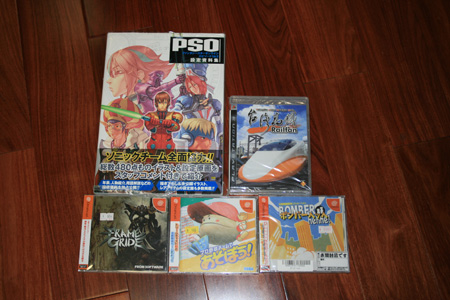
(clockwise from upper left)
Phantasy Star Online artbook, purchased at Mandarake in Shibuya.
Railfan: Taiwan High Speed Rail, purchased in the Shin Kong Mitsukoshi shopping mall in Tainan, Taiwan. This is the PS3 game that I alluded to several posts ago. I bought this even though I don’t even have a PS3 system and have no plans to get one anytime soon! But I did ride the Taiwan HSR twice last month, which was pretty cool. This game lets you drive it.
Bomber hehhe!, purchased at MediaLand in Akihabara. This is an obscure game about blowing up skyscrapers and one I’ve been wanting to get for years. I believe this game was released after 9/11, which is surprising in itself.
Pro Yayku Team de Asobou! (Let’s play pro baseball team!), purchased at Super Potato in Akihabara.
Frame Guide, purchased at Super Potato in Akihabara.
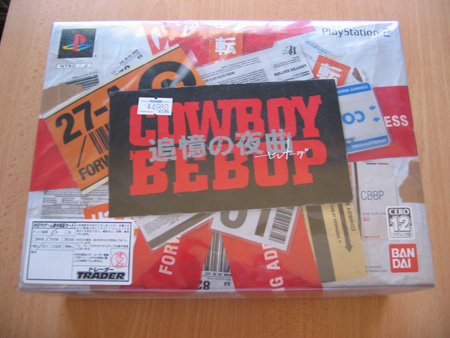
Cowboy Bebop limited edition boxed set, purchased at Trader in Shinjuku. This is the PS2 game based on the popular anime series.

An assortment of music CDs purchased at Book Off in Harajuku and HMV in Shibuya. (clockwise from upper left)
melody. “Be as one” album
melody. “Lovin’ U” single
melody. “Ready to go!” album
Genki Rockets “Heavenly Star” single
Nobuchika Eri “nobuchikaeri” album
Leah Dizon “Koi shiyou” single
Most of these games and music CDs were purchased used, which has none of the negative connotations associated with it in the U.S. In fact, I prefer buying used goods when I’m in Tokyo. The conditions are graded with labeled tags by the stores, and you get high quality merchandise at the low prices. For example, I found a used copy of the melody. “Ready to go!” album a few days after its official release in stores. I bought it for $10 less than the new price and the condition was pristine.
Taipei 101 surpassed
It was announced today that the Burj Dubai skyscraper in Dubai, currently in construction, is now the world’s tallest building. That means Taipei 101 in Taipei, Taiwan has been stripped of that honor, which it held for several years.
Oh well, Taipei 101 had a good run. It’s too bad I just got back from Taiwan, since it would have been interesting to see what people thought about this news. Maybe I’ll watch the Chinese news channel tonight.
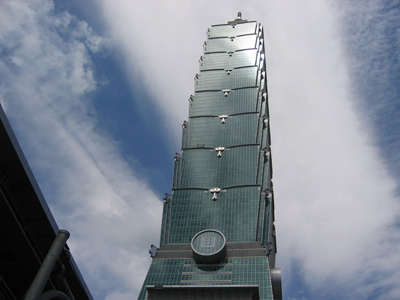
I snapped this photo outside the Taipei World Trade Center, where I was attending the 2007 Taipei Digital Audio & Video Expo. I have more photos to come when I finish organizing everything. In total, I took almost 5,000 photos in the last month on vacation.
Perfect timing
I’m at the Kaohsiung airport right now, flying to the Taoyuan Airport near Taipei so that I can connect to a Los Angeles flight. I thought I would check the D-Addicts forum briefly to see whether subtitles for the 2nd episode of Yama Onna Kabe Onna had been posted (they weren’t up earlier this morning). Lo and behold, the subs are up! Now the trans-Pacific flight will feel one hour shorter ;)
More on Yama Onna Kabe Onna when I get back. I also bought my first PlayStation 3 game despite having no plans to get the system anytime soon. Bet you can’t guess what it is…
